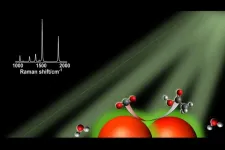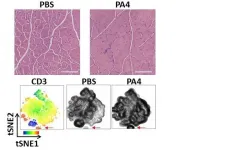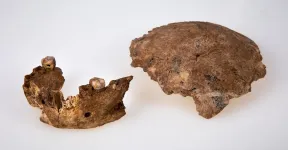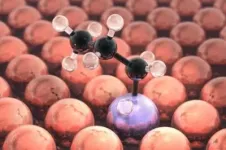(Press-News.org) For the past several years, chemical engineer Michelle O'Malley has focused her research on the anaerobic fungi found in the guts of herbivores, which make it possible for those animals to fuel themselves with sugars and starches extracted from fibrous plants. O'Malley's work, reflected in multiple research awards and journal articles, has centered on how these powerful fungi might be used to extract value-added products from the nonedible parts of plants -- roots, stems and leaves -- that are generally considered waste products.
Now, her lab has discovered that those same fungi likely produce novel "natural products," which could function as antibiotics or other compounds of use for biotechnology. The research is described in a paper titled "Anaerobic gut fungi are an untapped reservoir of natural products," published in the Proceedings of the National Academy of Sciences (PNAS).
All living things are equipped with natural defenses to ensure their survival. Microbes often depend on synthesized natural products that act as defenses against environmental threats and allow them to compete with other microbes. Many such natural products have served as the source of antibiotics used to fight disease in humans.
Anaerobic fungi, by definition, do not use oxygen to fuel their production of natural products. Thus, said O'Malley, "It costs them a lot more metabolically to make something than it does an aerobe." Further, anything an anaerobic microbe produces has to be carefully "designed" and extremely efficient, since energy is scarce in the oxygen-free microbes.
O'Malley's lab in 2017 provided the U.S. Department of Energy with several anaerobic gut fungi, which were then sequenced as part of a larger collaboration.
"We started seeing something we didn't expect to find: the building blocks -- biosynthetic gene clusters, or BGCs -- that antibiotics are typically built from," O'Malley said of that work. "BGCs sit near each other on the genome and participate in stepwise chemical reactions. In this case, they are loading a molecule onto an enzyme -- chemically decorating it, if you will -- and then passing it to another enzymatic module and, in this way, making it into an increasingly complex molecule."
That molecular assembly-line process is important, she says, because it emulates how antibiotics are often made. "BGCs could also be of useful for making value-added chemicals, because they have lot of complex chemistry built in," she added. "So, they might be able to be used as drop-in biofuels, as coatings, and as monomers to make novel materials."
But the most important implications, she said, are the antibiotic possibilities. In the paper, lead author Candice Swift, who earned her Ph.D. in O'Malley's lab and is now a postdoctoral researcher at the University of South Carolina's School of Public Health, demonstrates not only that the BGCs are present where they were not expected to be -- anaerobic fungi have never been thought to have antibiotic properties -- they are, even more surprisingly, active and actually making something. "They are transcribed," O'Malley noted.
Swift's analysis suggests that the compounds they found have not been identified previously. "We discovered them, and, based on what is known about these biosynthetic gene clusters, they could be making novel antibiotics," O'Malley said. "We haven't shown that definitively here, but it's one possibility that would make sense, because the fungi exist as kind of minority players in their community, so they probably have some edge or ability that allows them to stick around in the face of overwhelming competition. That's what we think they might be doing. We haven't proven it, but it's an attractive way to look at it."
So, if the anaerobic fungi are producing natural antibiotics, how difficult would it be to translate them into use in humans? "If you identify a novel antibiotic, the key to making that at scale is knowing how it's built," O'Malley explained. "That's a big question. We'll try to address that in a follow-up paper, but if you can figure out the genetic recipe for how they're made, it's straightforward to apply it in another system."
O'Malley said that the scientific community "has become pretty good at making antibiotics, recombinantly or through genetic engineering," and that all, or nearly all antibiotics, are derived from natural products -- either made in nature or inspired by the compounds that nature builds.
The next stage in this research will involve using genetic tools to boost production and isolate the compounds to figure out exactly what compounds are being made. For that work, O'Malley is partnering with other researchers in the BioPolymers, Automated Cellular Infrastructure, Flow, and Integrated Chemistry Materials Innovation Platform (BioPACIFIC MIP), which the National Science Foundation funded last year as a collaboration between UCSB and UCLA.
INFORMATION:
The body's immune cells naturally fight off viral and bacterial microbes and other invaders, but they can also be reprogrammed or "trained" to respond even more aggressively and potently to such threats, report UCLA scientists who have discovered the fundamental rule underlying this process in a particular class of cells.
In END ...
CHAMPAIGN, Ill. -- Researchers report that small quantities of useful molecules such as hydrocarbons are produced when carbon dioxide and water react in the presence of light and a silver nanoparticle catalyst. Their validation study - made possible through the use of a high-resolution analytical technique - could pave the way for CO2-reduction technologies that allow industrial-scale production of renewable carbon-based fuels.
The study, led by University of Illinois Urbana-Champaign chemistry professor Prashant Jain, probes chemical activity at the surface of silver nanoparticle catalysts under visible light and uses carbon isotopes to track the origin and production of these previously undetected chemical reactions. The findings are published in the journal Nature Communications.
Sunlight-driven ...
By Benjamin Boettner
(Boston) - Muscular dystrophies are a group of genetic diseases that lead to the progressive loss of muscle mass and function in patients, with the incurable Duchenne Muscular Dystrophy (DMD), which affects all the body's muscles primarily in boys, being particularly severe. DMD can be caused by more than 7,000 unique mutations in the largest gene of the human genome, which encodes a central protein in muscle fibers. While this astounding number of mutations all variably block muscle function, the affected muscles share another common feature - chronic inflammation.
As chronic inflammation ...
Scientists need to focus on tangible efforts to boost equity, diversity and inclusion in citizen science, researchers from North Carolina State University argued in a new perspective.
Published in the journal Science, the perspective is a response to a debate about rebranding "citizen science," the movement to use crowdsourced data collection, analysis or design in research. Researchers said that while the motivation for rebranding is in response to a real concern, there will be a cost to it, and efforts to make projects more inclusive should go deeper than that. Their recommendations speak to a broader discussion about how to ensure science is responsive to the needs of a diverse audience.
"At its heart, citizen science is a system of knowledge production ...
Parents of children with the most complex medical conditions are more likely to report poor or fair mental health and struggle to find community help, according to a study completed by researchers at University of Rochester Medical Center (URMC) and Golisano Children's Hospital. The study was published in Pediatrics, the journal of the American Academy of Pediatrics (AAP).
The study, "A National Mental Health Profile of Parents of Children with Medical Complexity," examined parent-reported data from the National Survey of Children's Health, and compared three groups: households of children with medical complexity (CMC), households of noncomplex children with special health care needs, and households of children ...
Not all stresses are created equal, according to a pair of new studies, which shows that distinct ubiquitination patterns underlie cell recovery following different environmental stressors. Eukaryotic cells respond to environmental stressors - such as temperature extremes, exposure to toxins or damage, for example - through adaptive programs that help to ensure their survival, including the shutdown of key cellular processes. These responses are often associated with the formation of stress granules (SGs) - dense cytoplasmic aggregations of proteins and RNA - as well as with ...
Although the Antibody Mediated Prevention (AMP) study that launched in 2016 failed to show significant efficacy in a pair of clinical trials, Denis Burton argues in a Perspective that the AMP study's results represent a landmark in AIDS research; they show - for the first time - that a broadly neutralizing antibody (bnAb) can protect humans against exposure to some strains of HIV. According to Burton, the AMP study's data - despite not showing a significant difference between the numbers of infected individuals in the treated groups versus those in the placebo groups - still have tremendous implications for future HIV vaccine design and passive bnAb use strategies. The AMP study evaluated the immunotherapeutic ...
BINGHAMTON, N.Y. -- Analysis of recently discovered fossils found in Israel suggest that interactions between different human species were more complex than previously believed, according to a team of researchers including Binghamton University anthropology professor Rolf Quam.
The research team, led by Israel Hershkovitz from Tel Aviv University, published their findings in Science, describing recently discovered fossils from the site of Nesher Ramla in Israel. The Nesher Ramla site dates to about 120,000-140,000 years ago, towards the very end of the Middle Pleistocene time period.
The human fossils were found by Dr. Zaidner of ...
Researchers at Tufts University, University College London (UCL), Cambridge University and University of California at Santa Barbara have demonstrated that a catalyst can indeed be an agent of change. In a study published today in Science, they used quantum chemical simulations run on supercomputers to predict a new catalyst architecture as well as its interactions with certain chemicals, and demonstrated in practice its ability to produce propylene - currently in short supply - which is critically needed in the manufacture of plastics, fabrics and other chemicals. The improvements have potential for highly efficient, "greener" chemistry with a lower carbon footprint.
The demand for propylene is ...
The discovery of a new Homo group in this region, which resembles Pre-Neanderthal populations in Europe, challenges the prevailing hypothesis that Neanderthals originated from Europe, suggesting that at least some of the Neanderthals' ancestors actually came from the Levant.
The new finding suggests that two types of Homo groups lived side by side in the Levant for more than 100,000 years (200-100,000 years ago), sharing knowledge and tool technologies: the Nesher Ramla people who lived in the region from around 400,000 years ago, and the Homo sapiens who arrived later, some 200,000 years ago.
The new discovery also gives clues about a mystery in human evolution: How did genes of Homo sapiens penetrate the Neanderthal population that had presumably lived in Europe long before ...




